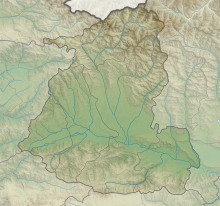Shida Kartli
Inner Kartli
შიდა ქართლი | |
|---|---|
Russian occupied part of Shida Kartli |
Shida Kartli (Georgian: შიდა ქართლი, šida kartli, [ʃida kʰaɾtʰli]; "Inner Kartli") is a landlocked administrative region (Mkhare) in eastern Georgia. It comprises a central part of the historical-geographic province of Shida Kartli. With an area of 5,729 square kilometres (2,212 sq mi), Shida Kartli is the 8th largest Georgian region by land area. With 284,081 inhabitants, it is Georgia's seventh-most-populous region. Shida Kartli's capital and largest city, Gori, is the 5th largest city in Georgia.[3]
The region is bordered by the
The northern part of the region, namely
Etymology
The name Shida Kartli in English translates as Inner Kartli. The term Kartli itself derives from
Geography

Shida Kartli is located in a central part of the lowland between
The region's northern border is formed by the
Relief

Overall picture of Shida Kartli's relief is formed by extensive Shida Kartli plain and mountainous edges. The main orographic entities of the region are: small parts of the Greater Caucasus mountains and Racha range, Germukhi, Kharuli, Kvernaki, Trialeti, Likhi ranges and Shida Kartli plain.[8]
The average height of the Shida Kartli terrain is 1,307 meter. The lowest point is at 473 meter in

Climate
Shida Kartli has various
Temperature

An
Precipitation
On the territory of Shida Kartli an average annual precipitation equals to 824 mm. Maximum of a precipitation (1,045 mm) falls to the very north of the region, on the Caucasus Mountains, while the minimum (536 mm) falls to the east of Kaspi Municipality, along Mtkvari valley. By abundance of precipitation, the northern part of the region stand out: its amount varies from 800 mm up to 1,045 mm. On the Shida Kartli plain, average annual precipitation varies from 563 mm up to 800 mm, and on the Trialeti Range from 700 mm up to 900 mm.[11]
By month, maximum average annual precipitation falls in May (109 mm) and June (105 mm), while the minimum falls in February (57 mm).[12]
Winds
In Shida Kartli the strongest
By territorial distribution winds are especially strong on the southern slopes of the Greater Caucasus Mountains, while the weakest are on the Shida Kartli plain.[12]
See also
- Subdivisions of Georgia
- Kartli
- Samachablo
- 2008 Russo-Georgian war
- Russian-occupied territories in Georgia
Notes
- ^ South Ossetia's status is disputed. It considers itself to be an independent state, but this is recognised by only a few other countries. The Georgian government and most of the world's other states consider South Ossetia de jure a part of Georgia's territory.
References
- ^ "City Gori". shidakartli.gov.ge. Government of Georgia. Retrieved 8 March 2018.
- ^ "Governor". shidakartli.gov.ge. Government of Georgia. Retrieved 4 February 2022.
- ^ a b "Statistics of Shida Kartli Region". www.geostat.ge. The National Statistics Office of Georgia. Retrieved 5 August 2021.
- ^ "Sub-national HDI – Area Database – Global Data Lab". hdi.globaldatalab.org. Retrieved 2018-09-13.
- ISBN 9783110156584. Retrieved 7 June 2015.
- ISBN 9789004161092. Retrieved 7 June 2015.
- ^ "შიდა ქართლის რეგიონის განვითარების სტრატეგია. 2014–2021" (PDF). gov.ge. Government of Georgia. Retrieved 8 March 2018. (in Georgian)
- ^ Sokhadze, Marine (2008). საქართელოს ატლასი [Atlas of Georgia] (in Georgian). Tbilisi: Bakur Sulakauri Publishing.
- ^ "ASTER Global Digital Elevation Map". asterweb.jpl.nasa.gov. NASA. Retrieved 8 March 2018.
- ^ Kordzakhia, Mitropane (1961). საქართველოს ჰავა [Climate of Georgia] (in Georgian). Tbilisi: Georgian SSR Science Academy.
- ^ doi:10.1002/joc.1276.
- ^ S2CID 134866404.

